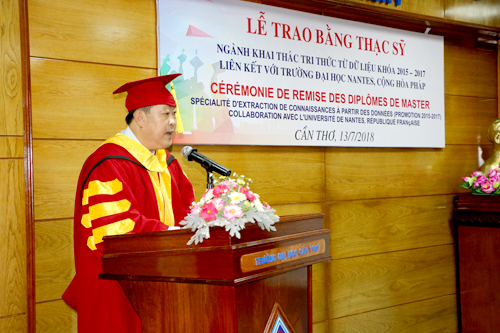
 Tên đề tài: “Nghiên cứu ảnh hưởng của chất điều hòa sinh trưởng thực vật brassinolide đến khả năng chịu mặn của lúa cao sản vùng đồng bằng Sông Cửu Long”.
Tên đề tài: “Nghiên cứu ảnh hưởng của chất điều hòa sinh trưởng thực vật brassinolide đến khả năng chịu mặn của lúa cao sản vùng đồng bằng Sông Cửu Long”.
 Tác giả: Lê Kiêu Hiếu, Khóa: 2015
Tác giả: Lê Kiêu Hiếu, Khóa: 2015
 Chuyên ngành: Khoa học cây trồng; Mã số: 62620110. Nhóm ngành: Nông, lâm nghiệp và thuỷ sản.
Chuyên ngành: Khoa học cây trồng; Mã số: 62620110. Nhóm ngành: Nông, lâm nghiệp và thuỷ sản.
 Người hướng dẫn chính: GS.TS. Nguyễn Bảo Vệ - Trường Đại học Cần Thơ.
Người hướng dẫn chính: GS.TS. Nguyễn Bảo Vệ - Trường Đại học Cần Thơ.
 Người hướng dẫn phụ: PGS.TS. Phạm Phước Nhẫn - Trường Đại học Cần Thơ.
Người hướng dẫn phụ: PGS.TS. Phạm Phước Nhẫn - Trường Đại học Cần Thơ.
- Tóm tắt nội dung luận án
Luận án được thực hiện từ năm 2015 đến năm 2018. Kết quả đạt được như sau:
Trong điều kiện cây lúa bị mặn, brassinolide đã tác động lên các đặc tính sinh lý, sinh hóa của cây bao gồm hàm lượng proline, hàm lượng các sắc tố quang hợp và hoạt tính enzyme thủy phân protease để giúp cây gia tăng khả năng chịu mặn. Trường hợp độ mặn (6‰), brassinolide nồng độ 0,10mg/L có tác động tích cực đến enzyme catalase, gia tăng hấp thụ đạm của cây (Ntổng số tăng 10,97% so với đối chứng); nồng độ BL 0,05 mg/L làm tăng sự hấp thụ lân (tăng 39,19%) cũng như làm giảm hấp thụ natri của cây (giảm 11,70%).
Phun brassinolide giúp cải thiện sự sinh trưởng và năng suất lúa khi bị mặn. Nồng độ dung dịch phun brassinolide thay đổi tùy theo độ mặn và giai đoạn sinh trưởng của cây lúa như sau:
- Khi cây lúa bị mặn 3‰ ở giai đoạn mạ, phun brassinolide có nồng độ 0,05 mg/L giúp gia tăng khối lượng hạt trên chậu 9,17% so với không xử lý, còn ở độ mặn 6‰, xử lý phun brassinolide không làm thay đổi khối lượng hạt/chậu.
- Khi cây lúa bị mặn 3‰ vào thời điểm đẻ nhánh, phun brassinolide nồng độ 0,05 mg/L có hiệu quả cải thiện tích cực đến khối lượng hạt trên chậu (tăng 29,58% so với đối chứng), còn ở độ mặn 6‰, phun brassinolide có nồng độ 0,10 mg/L giúp lúa cải thiện khối lượng hạt/chậu tốt nhất (tăng 25,73% so với đối chứng).
- Khi lúa bị mặn 3‰ ở giai đoạn tượng đòng và trổ, phun brassinolide 0,10 mg/L làm tăng khối lượng hạt/chậu 48,50% và 44,62%, còn ở độ mặn 6‰ làm tăng khối lượng hạt/chậu 58,97% và 54,79%.
Trong điều kiện đồng ruộng bị mặn 3-5‰ ở tỉnh Bạc Liêu, phun brassinolide 3 lần/vụ (0,05 mg/L brassinolide ở giai đoạn mạ, 0,1 mg/L brassinolide lúc nhảy chồi và tượng đòng) giúp cải thiện sự sinh trưởng và gia tăng năng suất lúa từ 21 đến 29%.
- Những kết quả mới của luận án
- Luận án đã xác định được brassinolide có tác động tích cực đến một số đặc tính sinh lý, sinh hóa của lúa như proline, sắc tố quang hợp, enzyme thủy phân protease, enzyme catalase, đạm, lân và natri trong gia tăng khả năng chống chịu mặn.
- Luận án đã tìm ra được nồng độ xử lý brassinolide khi lúa bị mặn như sau: (1) Ở độ mặn 3‰: Lúa bị mặn ở giai đoạn mạ hoặc đẻ nhánh xử lý brassinolide nồng độ 0,05 mg/L, còn khi bị mặn ở giai đoạn tượng đòng hoặc trổ xử lý brassinolide nồng độ 0,10 mg/L; (2) Ở độ mặn 6‰: Lúa bị mặn ở giai đoạn mạ xử lý brassinolide nồng độ 0,05 mg/L, còn khi cây lúa bị mặn ở giai đoạn đẻ nhánh, tượng đòng hoặc trổ xử lý brassinolide nồng độ 0,10 mg/L.
- Luận án đã xác đinh được trong điều kiện đồng ruộng bị mặn từ 3 đến 5‰ ở tỉnh Bạc Liêu, phun brassinolide 3 lần/vụ (0,05 mg/L brassinolide ở giai đoạn mạ, 0,1 mg/L brassinolide lúc nảy chồi và tượng đòng) giúp cải thiện sự sinh trưởng và gia tăng năng suất lúa 21-29%.
- Các ứng dụng/khả năng ứng dụng trong thực tiễn, các vấn đề cần tiếp tục nghiên cứu
- Kết quả nghiên cứu của luận án là cơ sở khoa học quan trọng, phục vụ tốt cho công tác nghiên cứu ứng dụng brassinolide giúp cây lúa chống chịu mặn và bổ sung tài liệu giảng dạy.
- Luận án đã cung cấp thông tin về giải pháp kỹ thuật giúp người trồng lúa giảm thiệt hại trong điều kiện cây lúa bị ảnh hưởng mặn.
- Luận án đã xác định được ảnh hưởng của chất điều hòa sinh trưởng thực vật brassinolide đến một số đặc tính sinh lý – sinh hóa của cây lúa khi bị mặn.
- Luận án đã tìm ra được nồng độ chất điều hòa sinh trưởng thực vật brassinolide xử lý cho cây lúa bị mặn ở những giai đoạn sinh trưởng và mức độ mặn khác nhau.
- Tiếp tục nghiên cứu trên nhiều giống lúa và trên nhiều loại đất mặn khác nhau để có thể rút ra kết luận chung.
- Cần tiếp tục nghiên cứu: xử lý mặn ở đầu vụ (cho vụ Hè Thu) và xử lý mặn ở cuối vụ (đòng, trổ) cho vụ Đông Xuân ở đồng bằng Sông Cửu Long.
1. Brief contents
The project entitled was carried out from the year 2015 to 2018. The results show that:
When rice living under saline conditions treated with brassinolide contributed to increasing proline, photosynthetic pigments, and protease activity which enhanced rice tolerance to salinity. At the 6‰-salted condition, brassinolide of 0.10 mg/L had also positive effects on catalase, total nitrogen content in shoots (10.97% higher than the control). Rice treated by brassinolide of 0.05 mg/L increased 39.19% of total phosphorous content but decreased 11.7% of total sodium content in shoots in comparison to those of the control.
Rice grown in salted conditions treated with brassinolide contributed to improving growth and rice yield. The concentrations of brassinolide solution for spraying varied among salinity levels and growing stages of rice as follows:
- Rice at the seedling stage in pots under the 3‰-salted condition and treated with brassinolide of 0.05 mg/L improved rice yield of 9.17% in contrast to that of brassinolide-free treatment. At a salinity of 6‰, however, brassinolide treatments caused no change in rice yield.
- At the tilling stage, when rice stressed with 3‰-salt and treated with brassinolide of 0.05 mg/L showed enhancement of yield per pot of 29.58% higher than that of the control. At the salt level of 6‰ and brassinolide application of 0.10 mg/L showed the most effective on rice yield, 25.73% higher than the counterpart of the control.
- At stages of panicle initiating and flowering, rice treated with brassinolide of 0.10 mg/L under the saline condition of 3‰ enhanced rice yield of 48.5% and 44.62%, respectively comparing to those of the controls. For those of 6‰ treatment were 58.97% and 54.79% of rice yield improvement, respectively.
In the natural-salted field of 3‰ and 5‰ in Bac Lieu province, brassinolide application 3 times per rice crop season: 0.05 mg/L brassinolide at the seedling stage, 0.10 mg/L brassinolide at the tilling stage and panicle initiating improved rice yield from 21% to 29%, respectively when compared to those of without brassinolide treatments.
2. The new findings of the dissertation- The thesis has identified several positive effects of brassinolide on the physiological and biochemical characteristics of rice. It contributed to increasing proline level, photosynthetic pigments, and protease activity which enhanced rice tolerance to salinity. - The thesis has determined the concentration of brassinolide treatment when rice living under the saline condition as follows: (1) At the 3‰-salted condition: rice at the seedling or tillering stage, brassinolide was used at 0.05 mg/L while rice at stages of panicle initiating and flowering, brassinolide should be applied at the concentration of 0.10 mg/L. (2) Brassinolide of 0.05 mg/L should be used for rice at the seedling stage under salinity of 6‰; at stages of tilling or panicle initiating and flowering, its application was 0.10 mg/L. - Under the natural-salted field of 3‰ and 5‰ in Bac Lieu province, brassinolide application 3 times per crop (0.05 mg/L BL at the seedling stage, 0.10 mg/L BL at the tilling stage and panicle initiating) improved growth and rice yield from 21% to 29%.3. Applications and suggestions for further study
- Results obtained from the thesis are important scientific proofs for the practical application of brassinolide on rice to improve tolerance to salinity and provide a significant resource for teaching.
- The dissertation provides information on possible technical solutions for farmers to reduce rice yield loss under-salted conditions.
- The thesis has recognized the effects of brassinolide concentrations on some physiological and biochemical characteristics of high yield rice under salt-stressed conditions.
- The thesis has suggested the efficient brassinolide concentrations to apply on rice affected by salt concentrations at seeding, tilling, panicle initiating, and flowering stage.
- Continue to study on other rice cultivars grown at different saline soils to draw general conclusions.
- Continue to study salt treatment at the beginning of the crop (for Summer-Autumn crop) and salt treatment at the end of the crop (panicle initiating + flowering stage) for the Winter-Spring crop in the Mekong Delta.
- Xem chi tiết nội dung luận án
- Xem thông tin đăng tải tại Website Bộ giáo dục và Đào tạo. (Nhập tên NCS vào ô tìm kiếm)




















